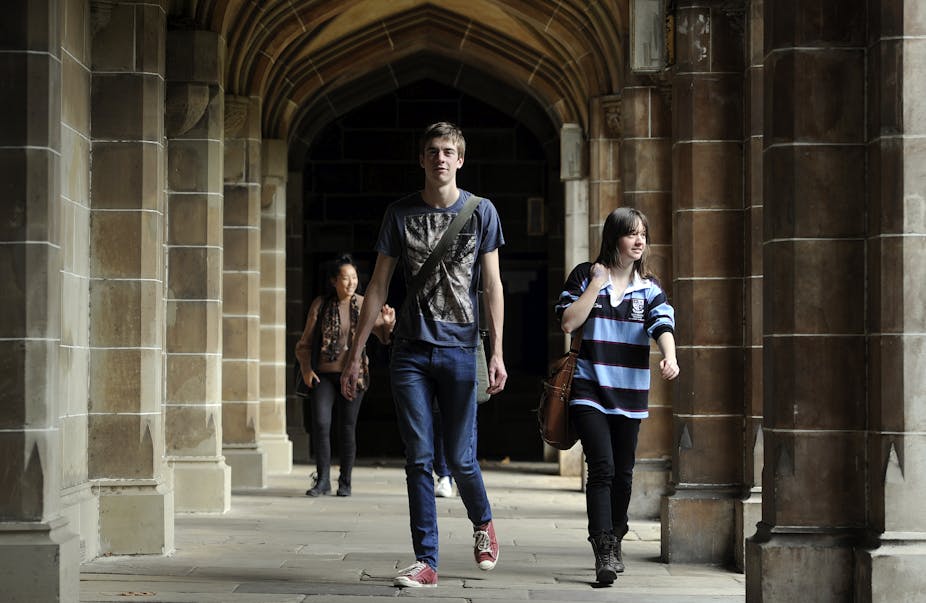In 1973, the Whitlam Labor government abolished university tuition fees. In 1987, the Hawke Government radically created thousands of extra university places by creating a national system, financing it via HECS.
Yet in the new millennium, Australian universities are still inaccessible to historically under-represented student groups.
Now it is the turn of the Gillard Labor Government to address the issue. It has set universities a target that by 2020 at least 20% of undergraduate students be from low socio-economic status (SES) backgrounds.
The tertiary education minister Chris Evans released earlier this month some initial figures, including a 3.3% increase in commencements for students from the targeted low SES sector.
The target is an admirable goal. But is it achievable?
Inspired to go
Let’s start with the catch-22: the very people universities are being asked to target are the ones that tend to reject university as an option very early in their life. Certainly there are exceptions but that’s the whole point: they are exceptions, not the norm.
So how can the government, and universities, inspire more of them? In a study of Black Male student success in higher education, Professor Shaun R. Harper of the University of Pennsylvania identified two main triggers of this inspiration. First, university was portrayed in the family home as a non-negotiable expectation. From childhood through high school, parents and other family members reinforced to the achievers that university was the most viable pathway to social uplift and success.
Second, the participants’ early schooling experiences almost always included at least one influential teacher who helped solidify their interest in going to college.
For a quintessentially Australian example, I thoroughly recommend reading Ken Wyatt’s maiden speech to Parliament. In this speech, Wyatt identifies many similar experiences and also highlights the importance of personal drive and motivation.
Exception to the rule
Which returns us to the essential catch-22. Currently, students like these are exceptions in universities because they have required exceptional motivation, exceptional parental expectation, and exceptional motivation. The same strategies do not work at a broader level.
In my own, preliminary, study of similar exceptional students, I have been struck by how many different strategies were adopted in order to achieve success. However, albeit tentatively at this early stage, I would put them into two broad categories that could be called “strategies of escape” and “strategies of indoctrination”.
In the former case, it is not so much that the individual wants to go to university; rather it is that they want to escape their own, particular circumstances and use university as the means. The problem with this strategy is that university is not the actual end goal. The person could equally use for example marriage, sport, or an overseas job to achieve the same goal.
A further problem is that it appears that students adopting this strategy tend to display higher levels of personal motivation than those in the other.
In the latter case - strategies of indoctrination – individuals are exposed both directly and indirectly to the “inevitability” of university. The idea is firmly planted when, as Harper’s study showed, university is described as non-negotiable.
As one of the participants in my study explained, “it wasn’t a case of do you want to go?” but “what do you want to do and do you have the brains for it?.” This can be achieved more subtly via a wide range of senses, including the books we read, television shows we watch, music we listen to and even the food we eat. This has been perhaps most famously demonstrated by French sociologist Pierre Bourdieu.
One of my own study’s participants remarked, “To this day, I remain someone who doesn’t like Neighbours, or Home and Away. I guess I grew up in a house with a bit of a high-brow disposition…”
A major advantage of this strategy, unlike the strategy of escape, is that the individual potentially requires lower levels of personal determination to succeed.
Bigger strategies
So what role can universities and governments play in supporting an individual’s strategies?
I would suggest first that there needs to be longer-term thinking. Although it’s important to support those entering university now, we must also pay attention to the ten-year olds who might attend university in 2020. Now is the time to start shaping their expectations.
The majority of programmes offered by universities kick in when the student is 15 or 16 years old and by then it is too late for too many.

Second, we must start to target and support the parents. After all, parents are the ones who will help form the expectations of students, both directly and indirectly.
And finally, the government needs to change its funding mix. Currently its focus is on rewarding results, not behaviour. That might sound counterintuitive, but it’s not. This year, the Federal Government has allocated around $176 million to support universities in increasing lower socio-economic enrolments.
The problem is that the vast majority - $132 million – will be paid on the basis of actual enrolments. That leaves only $44 million to support educational outreach activities, such as encouraging universities to work with schools in low SES suburbs. If that proportion were reversed then in all likelihood results will come slower – but when they do, they will be more impressive.

